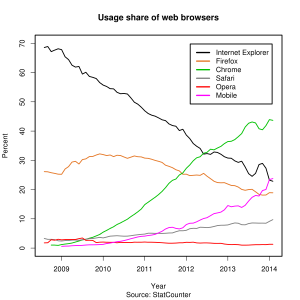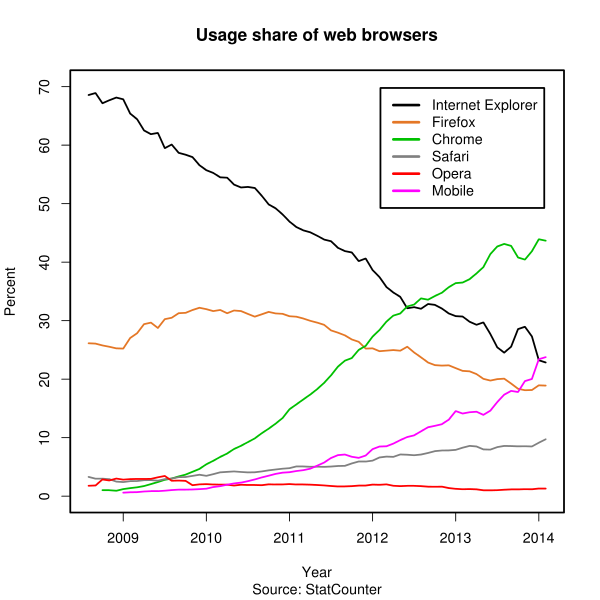The landscape of the Internet is ever-changing as is the way we absorb and consume Internet content. Over the past 10 years these changes have become more and more noticeable with major shifts occurring because of an increase in consumer options and a huge spike in accessibility and functionally of mobile devices. Let’s first take a look back at the Internet in 2004. At that point in time the world was dominated by PCs and bulky laptops, all equipped with Internet Explorer. In early 2004 Internet Explorer represented close to 94% of all website traffic. For consumer’s, there just weren’t many options out there and Internet Explorer came standard on all PCs and was easy to use. Browsers like Firefox were in their infancy while browsers such as Netscape Navigator had been steadily losing market share for years.
Over the next 5 years, from 2004 – 2009, Internet Explorer would remain, without question, the dominant web browser. An interesting trend was occurring however. Each month IE slowly was losing ground to competition. Browsers like Firefox & Safari and eventually Google Chrome (in late 2008) were starting to dissolve IE’s dominance. By the end of 2009 the break down of web traffic by browser looked something like this Internet Explorer still had over half of Internet traffic go through it’s browser with over 55% while Firefox made up close to 31% and Chrome & Safari made up about 6% and 4% respectively. Another blip came on the Internet radar in 2009 when mobile traffic made its first significant dent in the statistics pools with about 1.5% off Internet traffic coming from mobile devices.
 The next 5 years, from 2009 to present time, a mobile renaissance would take place while consumers continued to thrive off of choice in the desktop space. By 2014 Internet Explorer’s usage was cut in half to under 25% of all Internet traffic. Chrome saw the steadiest rise and became the premier browser of choice for laptop and desktop users by registering about 44% of the overall Internet traffic. Firefox has fluctuated up and down over the past 5 years and now makes up about 19% of traffic while Safari has had a slow but steady increase of usage to approximately 9.5%. The real story over the past 5 years has been mobile device traffic. By 2014, over 24% of Internet Internet traffic came from mobile devices. On average mobile traffic is increasing it’s share by .50% to .75% every month.
The next 5 years, from 2009 to present time, a mobile renaissance would take place while consumers continued to thrive off of choice in the desktop space. By 2014 Internet Explorer’s usage was cut in half to under 25% of all Internet traffic. Chrome saw the steadiest rise and became the premier browser of choice for laptop and desktop users by registering about 44% of the overall Internet traffic. Firefox has fluctuated up and down over the past 5 years and now makes up about 19% of traffic while Safari has had a slow but steady increase of usage to approximately 9.5%. The real story over the past 5 years has been mobile device traffic. By 2014, over 24% of Internet Internet traffic came from mobile devices. On average mobile traffic is increasing it’s share by .50% to .75% every month.
So what will the next 5 years hold for Internet consumers? What does the steady increase in mobile traffic mean for business ecosystems and environments? Of course only time will tell but we’d like to hear what you think. Share this post and your thoughts with us using #gravoc on Twitter or Facebook.
Statistics used for this blog post can be found through various resources including StatCounter.com and The Counter.com

